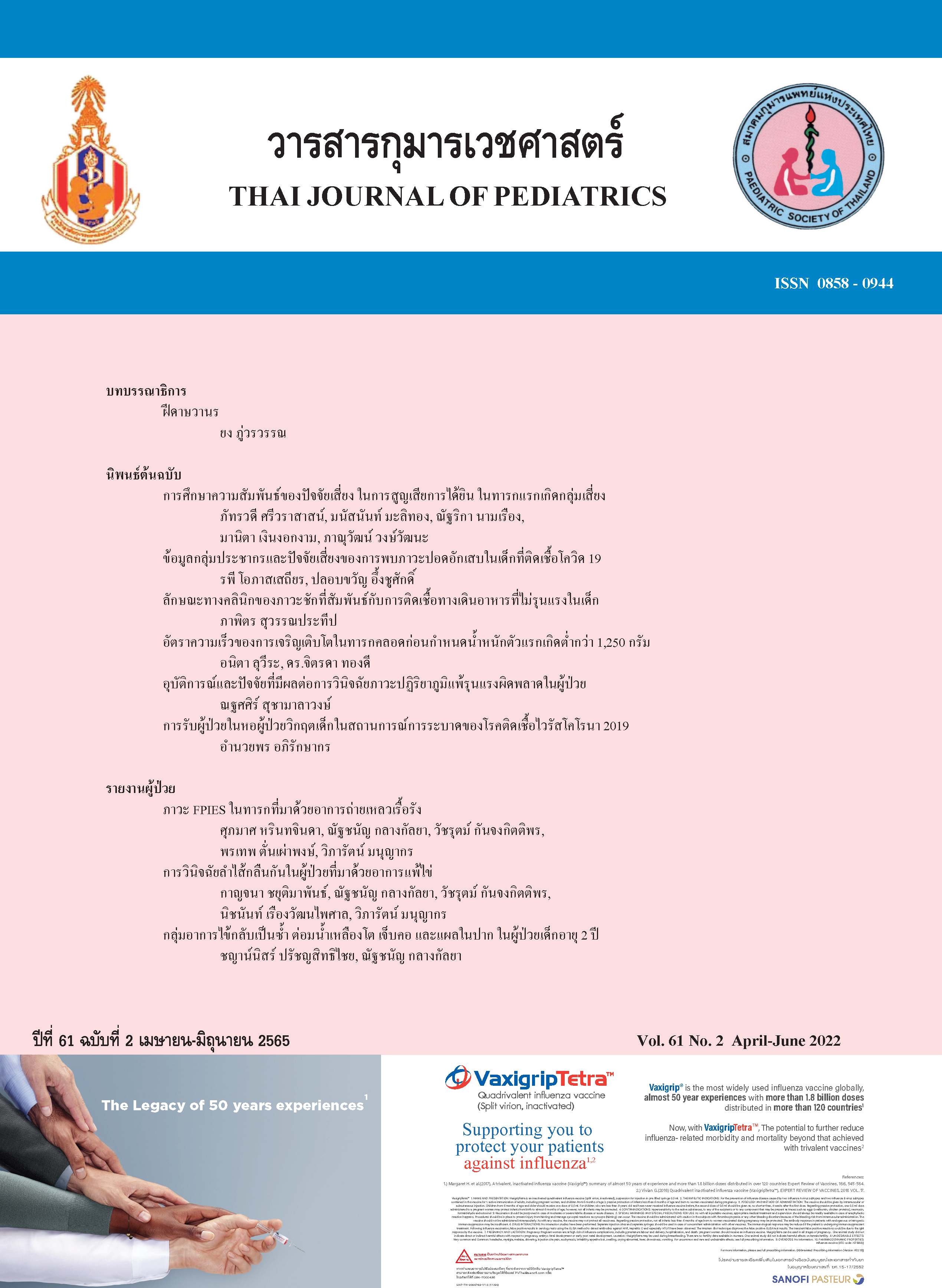อัตราความเร็วของการเจริญเติบโตในทารกคลอดก่อนกำหนดน้ำหนักตัวแรกเกิดต่ำกว่า 1,250 กรัม
คำสำคัญ:
ภาวะเจริญเติบโตช้าภายนอกครรภ์ EUGR อัตราความเร็วของการเจริญเติบโต growthvelocity Verypreterm infantบทคัดย่อ
ความเป็นมา: ปัญหาภาวะเจริญเติบโตช้าภายนอกครรภ์ (Extrauterine growth retardation, BUOR) เป็นปัญหาที่สำคัญที่พบบ่อยในทารกคลอคก่อนกำหนด ซึ่งส่งผลต่อเนื่องเกี่ยวกับสุขภาพด้านร่างกายและพัฒนาการในอนาคตและภาวะ EUGR มักสัมพันธ์กับทารกที่มีอัตราความเร็วของการเจริญเติบโตที่ช้าในขณะที่รักษาตัวอยู่ในโรงพยาบาล
วัตถุประสงค์: ศึกษาอัตราความเร็วของการเจริญเติบโต (Growh velociy) และปัจจัยเสี่ยงต่อการเกิดอัตราความเร็วของการเจริญเติบโตที่ช้าในช่วงทารกแรกเกิดในทารกที่คลอดอายุครรภ์น้อยกว่า 32 สัปดาห์ (Very pretemm infant) และน้ำหนักตัวแรกเกิดต่ำกว่า 1250 กรัม ตั้งแต่ มกราคม 2555 ถึง ธันวาคม 2563
วิธีการศึกษา: Descriptive study หาอัตราความเร็วของการเจริญเติบใตด้านน้ำหนักร่วมกับ retrospective analyic case control study ศึกษาปังชัยเสี่ยงของทารกที่มีอัตราความเร็วของการเจริญเติบโตที่ช้า คือ กลุ่มที่ Wcight gain velociy ต่ำกว่า 15 กรัมกิโลกรัม/วัน โดยคำนวณด้วยวิธี Exponcnial 2 point จากวันที่น้ำหนักตัวลดลงต่ำที่สุดถึงวันที่อายุครรภ์ครบ 36 สัปดาห์หรือได้กลับบ้าน (แล้วแต่อันใดมาถึงก่อนกัน)
ผลการศึกษา: ทารกที่เข้าเกณฑ์มีจำนวนทั้งหมด 17 รายมีอัตราความเร็วของการเจริญเติบโตค้านน้ำหนักเฉลี่ย 15.32.7 ครัม/คิโถกรัม/วัน พบทารกที่อัตราความเร็วของการเจริญเดิบโตที่ช้าด้านน้ำหนัก จำนวน 74 ราย (42.29 ) ผลเบื้องต้นพบเป็นกลุ่มที่มีน้ำหนักแรกเกิดต่ำกว่า (P -0. 131) เป็นเพศชายมากกว่า
(P =0.046), Apgar score ที่ 5 นาที 6 ในสัดส่วนที่สูงกว่า (>= 0.012), ทารกป่วยด้วยโรค RDS มากกว่า (D -0.001),พบกาวะ PDA มากกว่า P <0.,00 ) และมีภาวะเลือคออกในโพรงสมองชนิดรุนแรง (Severe IVH) มากกว่า p, 0.031) และเจ็บป่วยรุนแรงขณะรักษาตัวในโรงพยาบาลมากว่าอย่างชัดเจน แต่เมื่อ
ปัจจัยเสี่ยงเฉพาะช่วงแรกของชีวิตในการเกิดอัตราความเร็วของการเจริญเดิบโตที่ช้า พบว่านัยสำคัญทางสถิติมีเพียงโรค RDS OR 2.51 959CI 1.08-5.83 (p 0.033) และ PDA OR 2.66 95%CI 1.12-6.31 (P 0.025) เท่านั้น ทั้งนี้พบภาวะ EUOR รวมทั้งหมด 119 ราย (68%) และพบว่าในกลุ่มอัตราความเร็วของการเจริญเติบไตที่ข้ามี BUOR สูงถึง 86.5%
สรุป: ทารกคลอดก่อนกำหนดมีอัตราความเร็วของการเจริญเติบไตค้านน้ำหนักเฉถี่ย 153 土 2.7 กรัม/กิโลครัม/วันโดยปีชขัยเสี่ยงในช่วงแรกของชีวิตที่ทำให้ทารกมีอัตราความเร็วของการเจริญเติบโตที่ช้าได้แก่ การป่วยด้วยโรค RDS และ PDA
Downloads
เอกสารอ้างอิง
Izquierdo Renau M, Aldecoa-Bilbao V, Balcells Esponera C, Del Rey Hurtado de Mendoza B, Iriondo Sanz M, IglesiasPlatas I. Applying Methods for Postnatal Growth Assessment in the Clinical Setting: Evaluation in a Longitudinal Cohort of Very Preterm Infants. Nutrients. 2019;11(11):2772. Published 2019 Nov 14. doi:10.3390/nu11112772.
Griffin IJ, Tancredi DJ, Bertino E, Lee HC, Profit J. Postnatal growth failure in very low birthweight infants born between 2005 and 2012. Arch Dis Child Fetal Neonatal Ed.2016;101(1):F50-F55. doi:10.1136/archdischild-2014-308095.
Ramaswamy VV, Abiramalatha T, Bandyopadhyay T, Shaik NB, Bandiya P ,Nanda D, et al. ELBW and ELGAN outcomes in developing nations-Systematic review and meta-analysis. PLoS One. 2021;16(8):e0255352. Published 2021 Aug 5. doi:10.1371/journal.pone.0255352.
Takayanagi T, Shichijo A, Egashira M, Egashira T, Mizukami T. Extrauterine growth restriction was associated with short stature and thinness in very low birthweight infants at around six years of age. Acta Paediatr. 2019;108(1):112-117. doi:10.1111/apa.14433.
Ong KK, Kennedy K, Castañeda-Gutiérrez E, Forsyth S, Godfrey KM, Koletzko B,et al. Postnatal growth in preterm infants and later health outcomes: a systematic review. Acta Paediatr. 2015;104(10):974-986. doi:10.1111/apa.13128.
Peila C, Spada E, Giuliani F, Maiocco G, Raia M, Cresi F, et al. Extrauterine Growth Restriction: Definitions and Predictability of Outcomes in a Cohort of Very Low Birth Weight Infants or Preterm Neonates. Nutrients. 2020;12(5):1224. Published 2020 Apr 26. doi:10.3390/nu12051224.
Horbar JD, Ehrenkranz RA, Badger GJ, Edwards EM, Morrow KA, Soll RF et al.Weight Growth Velocity and Postnatal Growth Failure in Infants 501 to 1500 Grams: 2000-2013. Pediatrics. 2015;136(1):e84-e92. doi:10.1542/peds.2015-0129.
Ehrenkranz RA, Dusick AM, Vohr BR, Wright LL, Wrage LA, Poole WK. Growth in the neonatal intensive care unit influences neurodevelopmental and growth outcomes of extremely low birth weight infants. Pediatrics. 2006;117(4):1253-1261. doi:10.1542/peds.2005-1368
Fenton TR, Anderson D, Groh-Wargo S, Hoyos A, Ehrenkranz RA, Senterre T. An Attempt to Standardize the Calculation of Growth Velocity of Preterm InfantsEvaluation of Practical Bedside Methods. J Pediatr. 2018;196:77-83. doi:10.1016/j.jpeds.2017.10.005.
Fenton 2013 Electronic Growth Chart Available from:https://peditools.org/fenton2013/index.php.
Wright CJ,Posencheg MA,Seri I,Evans JR. Fluid, Electrolyte and Acid-Base Balance.In:Gleason CA,Juul SE,editors.Avery’s diseases of the newborn.10thed.Philadelphia,Elsevier;2018.p 368-389.
Raturi S, Zheng Q, Daniel LM, Shi L, Rajadurai VS, Agarwal PK. Nutritional intake and growth velocity in preterm extremely low-birthweight infants in Asia: Are we doing enough?. J Paediatr Child Health. 2017;53(12):1199-1207. doi:10.1111/jpc.13630.
Mabhandi T, Ramdin T, Ballot DE. Growth of extremely low birth weight infants at a tertiary hospital in a middle-income country. BMC Pediatr. 2019;19(1):231. Published 2019 Jul 11. doi:10.1186/s12887-019-1568-6.
Lee LY, Lee J, Niduvaje K, Seah SS, Atmawidjaja RW, Cheah FC. Nutritional therapies in the neonatal intensive care unit and post-natal growth outcomes of preterm very low birthweight Asian infants. J Paediatr Child Health. 2020;56(3):400-407. doi:10.1111/jpc.14634.
Jackson JC. Respiratory Disorders in the Preterm Infant. In:Gleason CA,Juul SE,editors.Avery’s diseases of the newborn.10th ed.Philadelphia,Elsevier;2018.p 653-667.
Zhao X, Ding L, Chen X, Zhu X, Wang J. Characteristics and risk factors for extrauterine growth retardation in very-lowbirth-weight infants. Medicine (Baltimore). 2020;99(47):e23104. doi:10.1097/MD.0000000000023104.
ดาวน์โหลด
เผยแพร่แล้ว
รูปแบบการอ้างอิง
ฉบับ
ประเภทบทความ
สัญญาอนุญาต

อนุญาตภายใต้เงื่อนไข Creative Commons Attribution-NonCommercial-NoDerivatives 4.0 International License.



